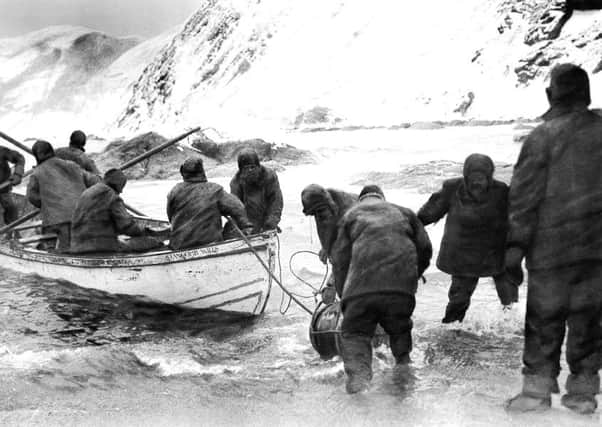Roger Cox: South Georgia and Shackleton on my mind


Thus, in his book South: The Endurance Expedition, Ernest Shackleton records the moment when he finally rescues his crew from Elephant Island, following one of the most remarkable episodes in the history of exploration. (The next thing he does, having inquired after everyone’s health, is to get them all smoking like chimneys: “As I drew close to the rock, I flung packets of cigarettes ashore; they fell on them like hungry tigers.”)
This emotional and tobacco-infused reunion took place on 30 August 1916, so the centenary is fast approaching, and to coincide with the occasion the Perthshire-based photographer and writer Jamie Grant has published a stunning book of images supplemented by short journal entries, made last year during his time as artist-in-residence on the island of South Georgia – another key location in the Shackleton saga. There is also an exhibition of his work at the Watermill Gallery in Aberfeldy, which runs until 11 September.
Advertisement
Hide AdAdvertisement
Hide AdWith his Imperial Trans Antarctic Expedition of 1914 in dire straits, his party stranded on the impossibly remote outcrop of Elephant Island, Shackleton decided on the whaling outpost of South Georgia, some 800 miles distant, as the best place to go looking for help. On 24 April, with a crew of five other men, he set sail aboard the James Caird – a tiny, 23-foot lifeboat made as seaworthy as possible with the materials available – and for 16 days battled the Great Southern Ocean before making landfall. Then, fuelled by albatross chick stew, Shackleton, Frank Worsley and Tom Crean made an equally miraculous overland journey to the whaling station at Stromness, where they raised the alarm.
During his seven-week residency on South Georgia, hosted by the South Georgia Heritage Trust, Grant was based at the former whaling station of Grytviken, just down the coast from Stromness. Shackleton is buried there – he died of a heart attack in 1922, aged just 47, when he returned on a subsequent expedition – and Grant includes a beautifully-lit image of the graveyard where he now lies. Significantly, perhaps, he doesn’t show us Shackleton’s grave itself, but the view from the spot where he is buried, which he describes as follows: “The sun cuts across Gull Lake, fingers along the lower slopes of Mount Hodges and delicately picks out the rows of white crosses against deep shadow.”
There are atmospheric images of some of Grytviken’s rusting whaling boats and abandoned whale processing plants, too, their ugliness contrasting starkly with the pristine white peaks towering in the background, but Grant achieves his most memorable results when he visits some of the island’s more inaccessible corners with members of the British Antarctic Survey. Among the stand-out pictures is a shot of the Nordenskjöld glacier in which its mighty blue ice cliffs dwarf the mountains behind; a breathtaking image of BAS technician “Ray” descending into the mist from the mountain ridge above King Edward’s Point after attempting to fix a radio repeater; and a dramatic picture of researcher “Ilaria” exploring diving petrel burrows in a huge area of grassland fringed by mountains that the Norwegians call “Hestesletten” or “the Horses’ plain”, in spite of its conspicuous lack of horses.
Ecological points are made with subtlety and thoughtfulness. At the enormous King Penguin colony at St Andrews Bay, Grant gets his best pictures when he opts to shoot the penguins, not as individuals or as groups, but “to see instead the entire colony and its surrounds as one interdependent entity.” The Nordenskjöld glacier, rapidly shrinking due to climate change, is described as being “like some gargantuan, wild animal that lies wounded, slowly dying.” And at Whalebone Cove, so-called because it is where whalebones thrown into the sea at Grytviken in the whaling years were later washed up by the tide, he observes: “Somehow the sea has brought these bones back, as if to say ‘look what you did, look what you left behind.’”
Grant strikes a hopeful note, too, however: after some species of whale were hunted almost to extinction, he reports that numbers in the waters around South Georgia are now on the rise, and there’s a wonderfully detailed close-up of an antique bone at Whalebone Cove in the process of being colonised by little tussocks of grass – an emblem of hope, if ever there was one. n
• Summer in South Georgia is published by Watermill Books, £20. An exhibition of Jamie Grant’s South Georgia photographs is on display at the Watermill, Aberfeldy, until 11 September, www.aberfeldywatermill.com; www.jamiemurraygrant.co.uk